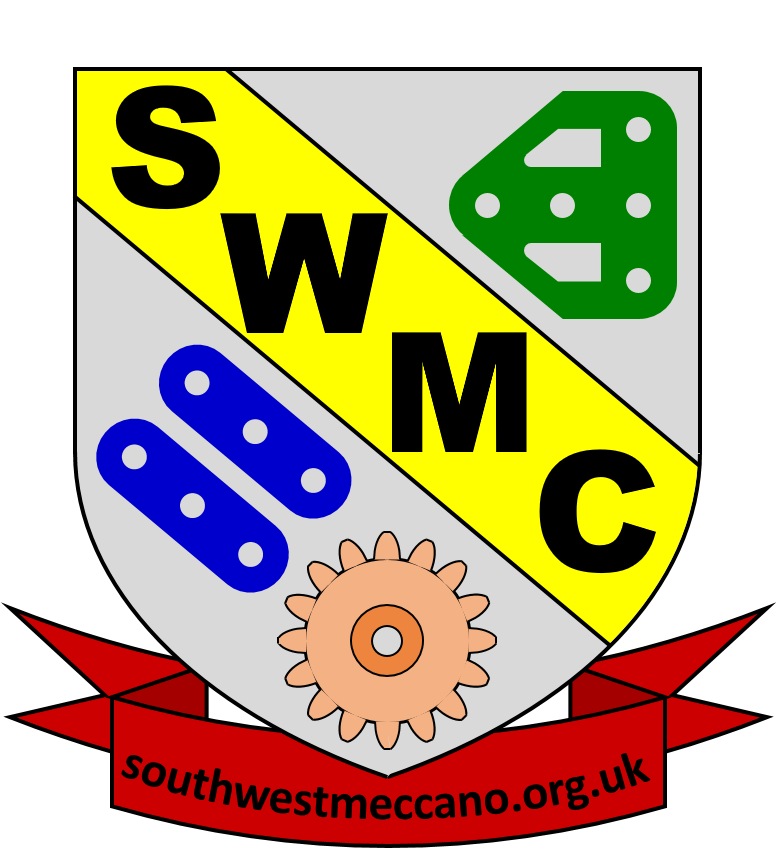January 2015 Meeting at Henleaze, Bristol - report from Neil Bedford
Models
This was an excellent meeting, very well attended and warmly hosted by Philip and Jane. Models displayed were as follows:-
Our host, Philip Drew, displayed two very impressive models, both partially completed. First was a new idea to extend the well-known ‘Tricky Track’ system with a mechanism very closely based on the Falkirk Wheel. Instead of lifting canal boats of course, Philip’s example will transfer a pair of little locomotives between an upper and lower track. The key feature of Tricky Track is that all of the mechanisms which the loco encounters are powered only by the wheels of the locomotive. To get the locomotive wheels to drive the ‘Falkirk Wheel’ is a tremendous challenge but Philip is well on the way to resolving it, with a differential involved in order to allow one locomotive to wait at the Falkirk Wheel until the second one arrives, so that they might both drive the wheel together, with everything being perfectly balanced. Philip’s second model was a roller-coaster and this is something which Philip has specialised in before, with plans published which have been used by Meccanomen (and women) repeatedly. Philip has built one car so far, to enable him to get the combination of slopes, twists and uphill sections absolutely perfect but ultimately there will be three cars.
Our President, Malcolm Hanson, brought along a K10 outfit. Malcolm explained that in the 1937/38 period, Meccano changed from ‘Lettered Sets’ to ‘Numbered Sets’ and a number of conversion sets were introduced to convert your lettered set to the next largest numbered set. The ‘K10’ converted a ‘K’ outfit to a Set 10. Malcolm has researched the history of this extremely rare set and it seems very possible that his might be the only example in the UK.
David Northcott brought along a charming clockwork-powered car in Nickel-plated parts from an early manual, featuring spoked wheels and some very nice old nickel components.
Michael Knowles displayed a front axle suitable for a large model lorry. This featured a beautifully made wheel hub for which Michael is seeking a suitable tyre. A complete lorry would be around 1/10th scale and one of Michael’s renowned gearboxes would set it off a treat.
David Miller brought along a model tramway. This was battery operated using a Meccano MR motor and collected power from an overhead wire. The model ran very well on ‘O’ gauge rails and the whole thing came apart to be transported on David’s push-bike!
Pete Evans demonstrated the loading bucket from his Marion 204 ‘Superfront’ shovel. Getting the hinged door of this bucket to lock and unlock remotely has given Pete some headaches but it has evolved to be a really neat mechanism. This large model is almost complete now and will be extremely impressive.
Sam Medworth has devised a simple mechanism to flash a light in time with the rotation of the propeller on his Sopwith Camel model. This has been achieved using the light-sensitive parts from the Meccano electrical set and should enable the aeroplanes machine guns to flash realistically. Sam also showed us a ‘trench periscope’ made from an early Meccano plan and featuring a pair of angled mirrors. This was an excellent little model, working perfectly and making us all consider the poor souls using such devices to peep over the top of a trench in the First World War whilst under fire.
Chris Bates brought along a very neat six speed and reverse gearbox based upon a design by Alan Wenbourne. This model utilised some pinions that had been milled to make them very thin and this enabled a great deal to be fitted into a small space. Chris also demonstrated a bascule bridge and dredger boat which he has constructed to entertain his Grandson. Great care has been taken to ensure that the bridge ‘works’ with roadways and ramps which are very smooth and free of bolt heads so that toy cars can easily zip along it.
Neil Bedford brought along a partially completed model of a German Hannover biplane and a pair of figures to pilot it. These articulated figures are built entirely from standard parts and are clothed in realistic uniforms which Neil has managed to make from scraps of thin felt.
Ralph Clark did not bring a locomotive this time, but did not stray too far, showing a single cylinder steam engine from a 1967 Meccano Magazine and powered by a clockwork motor. This model ran very well indeed.
Steve Briancourt brought along some examples of his answer to storing Meccano parts. Doubtless we all have our own ways of doing this but Steve has settled on a very tidy option, using sturdy plastic storage boxes with 12mm MDF in the bottom and with vertical 3.5 mm nails inserted at strategic points. In this way, Meccano parts can be stored without rubbing against one another, whilst being readily to hand and making excellent use of every bit of space.
Photos of the models can be seen at http://www.nzmeccano.com/image-84754
